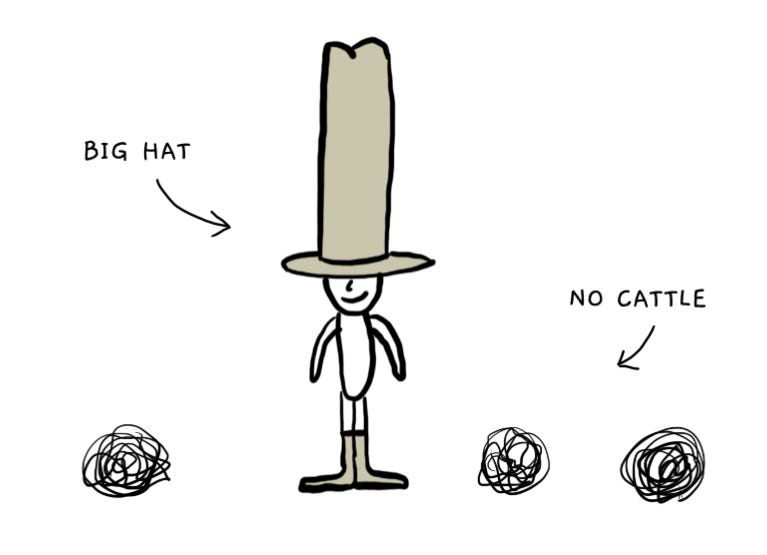Thinking Caps
Which hat should I wear?
Are we anything but the roles we play?
Be it at home, work, or play, we wear a dozen hats: Parent, friend, volunteer, manager, peer, runner, stamp collector.
We might be more than the sum of our roles, but the hats we wear determine our perspective. Thinking about our roles as hats lets us change them deliberately, don them when appropriate, or abandon them when they no longer serve us.
Our Own Hats
When I write this newsletter, I picture myself wearing four hats. The first is obvious: The Writer Top Hat. Under the brim, I’m thinking about ideas and how to articulate them. My mind wanders far and wide, and I don’t fret about reeling it in.
Because clarity is the job of the second hat: The Editor Fez. When wearing the Fez, I’m focused on making jumbled ideas more digestible to readers. What could I axe or reshape to craft a compelling message?
The third hat is the Illustrator Beanie. When inside the knitted cap, I consider the visuals to portray ideas I’ve written.
When not gathering dust, I wear the Marketer Ball Cap and think through sharing mechanisms. On which platforms could I publish the article? How do I tag it for SEO?
Wearing these metaphorical headpieces can balance the views required for individual pursuits. Understanding our own hat-switching is foundational for working with others.
The Hats of Others
Teams with diverse perspectives generate better outcomes, and assigning hats can accomplish this.
Edward de Bono proposes “Six Thinking Hats” in his book of the same title to guide group decision-making:
Yellow for positivity, to highlight the benefits of opportunities
Black for negativity, to consider the downsides with critical thinking
Red for emotions, to use gut feelings and assess how people will react
White for rationality, to use reason to analyze available data
Green for creativity, to generate ideas freely, without censorship
Blue for process, to recall the big picture and steer the group toward progress
When making a big decision—crafting a business strategy, designing a product, or hiring a leader—we can either:
Cycle through each hat as a group. For instance: Begin with a review of the data (White Hat), discuss opportunities (Yellow Hat), and then consider risks (Black Hat), or
Assign a hat to each member. For instance: Padma wears the White Hat, Jose wears the Red Hat, etc.
We should be deliberate about the points of view we want at the table. While we might expect Rational Padma to bring a data-driven mindset, explicitly asking for that perspective will make our intentions known and encourage participation.
These six hats aren’t the only approach to group decision-making. IDEO, a renowned design agency, advocates specific roles to manifest ideas in The Ten Faces of Innovation. Some people may gravitate toward top hats, others ball caps.
Conversely, the Catholic Church pioneered the “devil’s advocate” approach when considering a person for sainthood. A devil’s advocate was assigned to argue against the nominee to uncover any character flaws. Although the devil’s advocate might disagree with his claims, he dons the devil's horns for the team’s betterment—combatting groupthink with critical thinking.
We needn’t follow any framework religiously (ha), for we can assign hats per the circumstance. Imagine a three-person product team launching a new feature. The product manager might wear the “business hat,” the designer the “user hat,” and the engineer the “systems hat.” While the engineer might deeply understand the business needs, she takes responsibility for system considerations.
Worthy of the Crown
There’s an old cowboy idiom: “Big hat, no cattle.” A cowboy with a tall, fancy hat might talk a big game, but none of that matters if he doesn’t hold cattle—sufficient experience, resources, or training that qualify him for the perspective.
“Big hat, no cattle” is an antipattern that arises when one doesn’t fill the role she’s assigned. To combat this, ensure participants wear fitting hats. Don’t expect a salesperson to surface the technology considerations and vice-versa.
For a thinking cap to work, the wearer must be worthy of the crown.
TL;DR
What role should you fill?
What roles should others fill?
Assign roles appropriately; avoid big hats and no cattle
Junk Drawer
Read Trendline, a newsletter with intriguing data stories narrated with charts & visuals related to technology, business, and investing. Fewer than 2 mins to read!
Words that don’t translate into English








Excellent article. Helpful on many levels: as a product leader getting product team participation, as a way of critical thinking, as a way to be creative, and as a way to lead a team. Thank you Justin!
This is so good ! Love the illustrations!👍